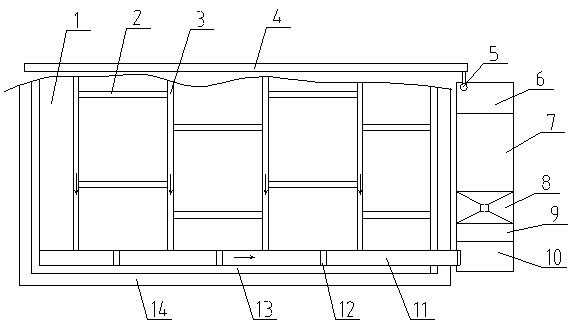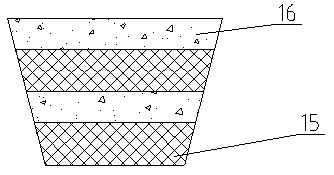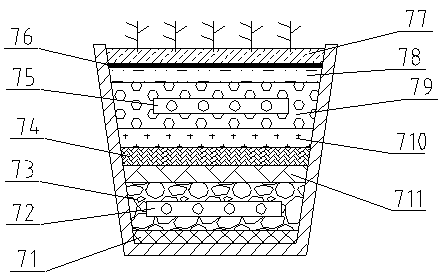Method for preventing and controlling nitrogen and phosphorus non-point source pollution in farmland
A non-point source pollution, nitrogen and phosphorus technology, applied in the field of prevention and control of nitrogen and phosphorus non-point source pollution in farmland, can solve the problems of large area and poor removal effect of nitrogen and phosphorus elements, so as to reduce the use of chemical fertilizers and avoid large area The effect of spreading and reducing the emission of nitrogen and phosphorus
- Summary
- Abstract
- Description
- Claims
- Application Information
AI Technical Summary
Problems solved by technology
Method used
Image
Examples
Embodiment 1
[0032] Such as Figure 1~3 As shown, the method for preventing and controlling farmland nitrogen and phosphorus non-point source pollution described in Example 1 includes the following prevention and control procedures:
[0033] ① Source control of farmland non-point source pollution:
[0034] When a field 1 is planting crops, use soil conditioner and chemical fertilizer to reduce the consumption of chemical fertilizer. The mass ratio of soil conditioner and chemical fertilizer per mu is 2:1. The preparation method of the soil conditioner is The biomass raw material particles with a percentage content of 20% are soaked in a 60% metal salt solution. After soaking for 10 hours, they are dried, dehydrated, and carbonized to obtain a soil conditioner. The carbonization is carried out in a tube furnace. Into nitrogen for atmosphere protection, the heating rate is 20°C / min, the carbonization temperature is 650°C, and the holding time is 1h. The biomass particles are pulverized wate...
Embodiment 2
[0045] Such as Figure 1~3 As shown, the method for preventing and controlling farmland nitrogen and phosphorus non-point source pollution described in Example 2 includes the following prevention and control procedures:
[0046] ① Source control of farmland non-point source pollution:
[0047]When a field 1 is planting crops, use soil conditioner and chemical fertilizer to reduce the consumption of chemical fertilizer. The mass ratio of soil conditioner and chemical fertilizer per mu is 2.5:1. The preparation method of described soil conditioner is to mix mass The biomass raw material particles with a percentage content of 30% are soaked in a 70% metal salt solution. After soaking for 15 hours, they are dried, dehydrated, and carbonized to obtain a soil conditioner. The carbonization is carried out in a tube furnace. Into nitrogen for atmosphere protection, the heating rate is 23°C / min, the carbonization temperature is 680°C, and the holding time is 1.5h. The biomass particle...
Embodiment 3
[0058] Such as Figure 1~3 As shown, the prevention and control method of farmland nitrogen and phosphorus non-point source pollution described in the present embodiment 3 includes the following prevention and control procedures:
[0059] ① Source control of farmland non-point source pollution:
[0060] When a field 1 is planting crops, use soil conditioner and chemical fertilizer to reduce the consumption of chemical fertilizer. The mass ratio of soil conditioner and chemical fertilizer per mu is 3:1. The preparation method of described soil conditioner is to mix mass Biomass raw material particles with a percentage content of 40% are soaked in 80% metal salt solution. After soaking for 20 hours, they are dried, dehydrated, and carbonized to obtain the soil conditioner. The carbonization is carried out in a tube furnace. Enter nitrogen for atmosphere protection, the heating rate is 25°C / min, the temperature of carbonization is 700°C, and the holding time is 2h. The biomass p...
PUM
 Login to View More
Login to View More Abstract
Description
Claims
Application Information
 Login to View More
Login to View More - R&D
- Intellectual Property
- Life Sciences
- Materials
- Tech Scout
- Unparalleled Data Quality
- Higher Quality Content
- 60% Fewer Hallucinations
Browse by: Latest US Patents, China's latest patents, Technical Efficacy Thesaurus, Application Domain, Technology Topic, Popular Technical Reports.
© 2025 PatSnap. All rights reserved.Legal|Privacy policy|Modern Slavery Act Transparency Statement|Sitemap|About US| Contact US: help@patsnap.com



